SUPPORT FOR RELATIVES LIVING OUTSIDE THE HOUSEHOLD
NETWORK TYPES AND LEVELS OF TRUST
CRIME AND SAFETY
PERSONAL STRESSORS
INFORMATION TECHNOLOGY
FINANCIAL STRESS AND INCOME
CULTURE AND LEISURE
SUMMARY OF FINDINGS
INTRODUCTION
Among the many, often inter-related, aspects of life that are important to human wellbeing are good health, good family relationships and engagements with wider social networks, good educational opportunities and outcomes, suitable employment, a decent income and freedom from financial stress, a decent and affordable place to live, feeling safe and secure, and having access to suitable transport. There is increasing recognition that many social phenomena are inter-related and social policy is becoming less sectoral as a consequence. In 2006, the Australian Bureau of Statistics (ABS) conducted the second General Social Survey (GSS), a multi-dimensional social survey that ranges across all of these aspects of life to enable analysis of the interrelationships in social circumstances and outcomes, including the exploration of multiple advantage and disadvantage.
The following commentary highlights some of the insights that can be obtained from the 2006 GSS, looking at various aspects of wellbeing and how they might be related to each other. The commentary also identifies some of the changes in people's circumstances since the first GSS was conducted in 2002.
SOCIAL NETWORKS
Relationships and networks are at the core of society and are essential to individual wellbeing. People are linked together with family and friends, and in wider communities characterised by shared interests, sympathies or living circumstances. Individuals may also form looser networks with people encountered through various activities and life situations. A person's networks may be concentrated in a local area, or more dispersed and sustained by travel and communications systems. There is a growing exploration of the ways in which social networks may contribute to positive outcomes for individuals in areas such as health and employment, and for communities in broader opportunities for participation and safer environments.
Of the 15,307,000 people aged 18 years and over covered in the 2006 GSS, most (96%) reported having contact in the previous week (either in person or via telephone, mail or e-mail) with family or friends with whom they did not live. The proportion of people reporting contact with family and friends in the last week was similar for both men and women and there was little variation across age groups, as was the pattern in 2002 (table 1). Of those people who had contact with family or friends in the last week, 79% did so in person, while an even greater proportion (93%) had weekly contact via other means such as telephone, mail or e-mail (table 2).
Over a 3 month period, most people used a combination of methods to contact family and friends, with fixed telephone being the most common (91%). The use of a mobile phone or Short Message Service (SMS) to contact family and friends was the next most common method (77%), followed by the internet for email or chat rooms (47%), and mail, cards or faxes (31%) (table 31). Mobiles and electronic forms of communication were more popular with younger age groups, whereas fixed telephone and mail were still heavily relied upon by older persons for distance communication.
In 2006, most people (93%) reported that they would be able to ask people outside of their household for small favours, such as looking after pets, collecting mail, watering gardens, minding a child for a brief period, or borrowing equipment (table 1). Similarly, most people (93%) reported that, in a time of crisis, they could get support from outside their household. While a similar proportion of men and women felt that they could get support in time of crisis, the younger age groups for both sexes (18 to 44 year olds) were more likely to feel they had support in a time of crisis compared to older age groups. People reporting that they could get support indicated that support would come primarily from family members (80%) or friends (67%). Neighbours, work colleagues and various community, government and professional organisations were also reported as other potential sources of support. No significant differences were found between men and women for any of the sources of support reported (table 25).
1 Sources of support in time of crisis, By sex
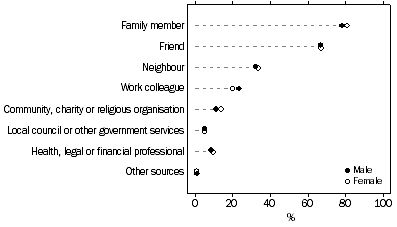
People born in countries other than main English-speaking ones were less likely than other people to report that they 'could ask for small favours' and be 'able to get support in a time of crisis' (table 12).
Family and household composition were generally not significantly associated with lower levels of support. Single parents or persons aged under 35 years and living by themselves had higher than average levels of daily face-to-face contact (27% and 31% respectively) and other forms of contact (52% and 60%) with family and friends living outside the household (table 8).
The level of social attachment, as measured by daily contact (all forms) with family and friends, ability to ask for small favours, and ability to get support in a time of crisis, generally increased progressively across each income distribution quintile from lowest to highest (table 9). Increasing levels of social attachment were also associated with increasing levels of good health (table 15).
SUPPORT FOR RELATIVES LIVING OUTSIDE THE HOUSEHOLD
With increasing numbers of parents not living with their natural children, there is an interest in their continuing relationships and the provision of support to their children. Similarly, the ageing of the population may mean that greater numbers of people are needing assistance from their children, other relatives and friends. Wider family networks often provide financial and physical support.
The 2002 and 2006 GSS cycles collected information on support provided by the selected person and/or their partner to any children aged 0 to 24 years living in other households, and support provided to other relatives living in other households. The data in 2002 did not distinguish between support provided by the selected person and support provided by their partner, or between the selected person's natural children or other relatives and their partner's children or other relatives. Additional data was collected in the 2006 GSS so that the differences between supporting one's own relatives and those of a partner could be analysed.
In 2006, there were 1,668,000 people aged 18 years and over who reported that their own children aged 0 to 24 years were living in another household. Of these people, 68% were providing some form of support to their own children. If partners' children and support are included, 1,961,000 people had children aged 0 to 24 years living in another household, of which 69% provided some form of support. The support arrangements included financial support (such as Child Support Payments, money to meet living or educational costs, or providing pocket money), and other forms of support (such as driving them places or lending them a car).
Support for children under 18 years of age living outside the household
In 2006, there were 570,000 people aged 18 years and over who reported that their own children aged under 18 years were living in another household. Of these people, 89% were providing some form of support to their own children. If partners' children and support are included, the number of people with children aged under 18 years living in another household was 742,000, of whom 89% provided support.
One of the key forms of financial support provided to children aged under 18 years living elsewhere is Child Support Payments. Child support can be paid by mutual agreement or may be imposed by a court order or following an application to the Child Support Agency. Child support is generally only paid for children under 18 years of age. Of those people who had children of this age living outside the household, 61% reported making Child Support Payments. People who lived alone were more likely (71%) than others to be making Child Support Payments (table 24).
Similar to results from the 2002 GSS, in 2006 males were more likely (71%) to pay child support for their own children aged under 18 years living elsewhere than were females (24%) (graph 2). Apart from Child Support Payments, people with their own children aged under 18 years living in another household provided or paid for clothing (46%), drove them places (41%), gave them pocket money or an allowance (39%), paid for educational costs or provided or paid for food (both 32%) (table 24).
2 Support provided for children aged 0-17 years, By sex of provider
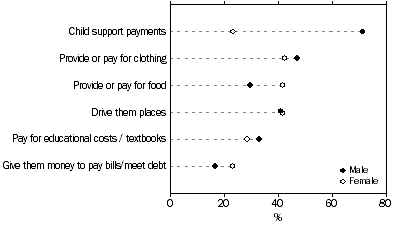
Support for children aged 18 to 24 years living outside the household
The age group 18 to 24 years is the period when children generally move from being dependent on their parents to living independently. While some children not residing with both natural parents may be living in the care of other families, many are living on their own, in group households or starting their own families. However, during this time, the continuation of material support from parents is often important in helping them establish their independence.
In 2006, there were 1,218,000 people aged 18 years and over who had their own children aged 18 to 24 years living away from them, of whom 57% provided some form of support to their own children. If partners' children and support are included, the number of people with children aged 18 to 24 years living in another household was 1,407,000, of whom 58% provided support.
Common types of support provided for children aged 18 to 24 years were money to pay bills or debt (30%), money to help pay rent and housing costs (21%), money for food (19%), driving them places (19%), letting them borrow the car (16%) and paying for educational expenses (15%). As Child Support Payments are provided predominantly for children aged under 18 years, the proportion of people providing child support for their own children aged 18 to 24 years was very low (table 24 and graph 3).
3 Support provided for children aged 18-24 years, By sex of provider
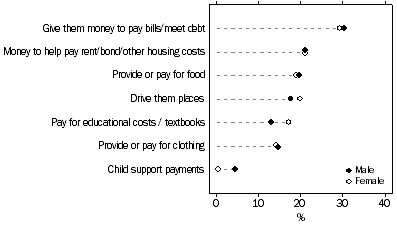
Support for other relatives living outside the household
Excluding partner support, in 2006, 4,296,000 people aged 18 years and over were providing some form of support to relatives, other than their own children aged 0 to 24 years, living outside the household. If partner support for other relatives is included, the number of people providing support rises to 4,838,000 people, up from 27% in 2002 (table 1).
In 2006, persons aged 55 to 64 years were more likely (36%) to support their relatives living elsewhere compared to other age groups (table 2). Persons aged 18 to 24 years and those aged 75 years and over were least likely to provide support to their relatives (21% for each age group). People in older age groups are more likely to be recipients of such care and support.
Transport was the most common form of assistance provided to other relatives, including driving other relatives places (15%) or letting them borrow a car (6%). The most common form of financial support was to give money to pay bills or meet debt (7%) (table 25).
NETWORK TYPES AND LEVELS OF TRUST
In addition to information collected in the 2002 GSS relating to the composition and quality of an individual's social networks, the 2006 GSS also measures the diversity of people's social networks, in terms of similarity of friends in age, educational background and ethnicity.
Of people aged 18 years and over, two-thirds (66%) reported that all or most of their friends were of a similar age. The youngest age group (18 to 24 year olds) had a higher rate of similarity in the ages of friends (74%) while the rate of similarity was lower (48%) for people aged 85 years or more. There was little variation in the rate of similarity for other age groups or by sex of the respondent. Similarly, over half (57%) of the population reported that all or most of their friends had a similar educational background. This was more common among younger age groups (64% for 18 to 24 year olds compared to less than 50% of persons aged 75 years or more). Overall, 73% of people reported that all or most of their friends were of similar ethnic background. However this tended to increase with age from 68% for those aged 18 to 24 years to 81% for those aged 85 years or more (table 31).
In 2006, just over one-third (37%) of persons had one or two family members living outside their household that they could confide in. Half of the population (53%) had three or more friends living outside their household that they could confide in. This figure decreased with age, as 65% of 18 to 24 year olds could confide in three or more friends compared to approximately one-third (36%) of those aged 75 years or more (table 31).
The 2006 GSS also assessed the levels of trust that respondents have in other people, including people in general and people associated with particular occupations and institutions. While only half of respondents (54%) felt that 'most people' could be trusted, they were more likely to trust their doctor (89%) and local police (76%). Levels of trust were similar across sex and age groups for most of the professions/institutions, about which feelings of trust questions were asked in the survey, though respondents in older age groups were more likely to trust their doctor (95% of those aged 75 years or more compared with 85% of 18 to 34 year olds) (table 25).
4 Community trust, By sex
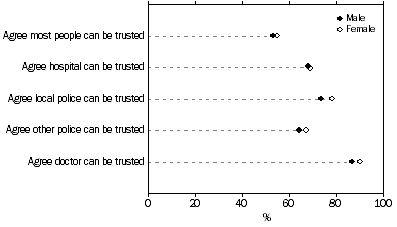
COMMUNITY INVOLVEMENT
Many people provide support to the wider community by voluntary work through organisations. In 2006, 5,227,000 people aged 18 years and more had undertaken some form of voluntary work in the previous 12 months (table 2). The rate of volunteering differed between the sexes, with 32% of men doing volunteer work in 2006 compared to 36% of women (tables 3 and 4). The rate of volunteering also differed with age, life cycle and location. People aged 35 to 44 years reported the highest rate of volunteering (43%) (table 2). People in a couple relationship with dependent children were more likely (45% of such persons) to volunteer than those in a couple relationship with no dependent children, lone parents or lone persons (table 8). Volunteer rates were noticeably lower in the major capital cities (32%) than elsewhere (39%) (table 7). For more information on voluntary work, see the related publication Voluntary Work, Australia (cat. no. 4441.0).
Support for the community can also be measured in the form of financial donations to organisations. In 2006, 77% of total persons aged 18 years and over had donated money in the last 12 months. The most popular types of organisations to which donations were given were community and welfare groups (61%), followed by hospitals/health organisations (32%) and schools (19%) (table 30).
People's involvement in the wider community through social activities and organised groups was measured in the 2006 GSS. In 2006, 63% of people had actively participated in one or more social groups during the last 12 months. There was some variation in such participation according to age. Younger persons aged 18 to 24 years had a higher rate of participation in social groups (67%) and the participation rate declined for those aged 75 years or more (54%). The most popular type of social participation for younger age groups was through sport and physical recreation groups (44% of 18 to 24 year olds). The most popular type of social participation for people aged 75 years or more was through religious or spiritual organisations (table 29).
One-third of people were actively involved in one or more community support groups in the last 12 months. The age group with the highest participation was 35 to 44 year olds (42%). Education and training groups, and parenting, children or youth groups, were the community support groups in which people of this age participated the most, reflecting their life cycle stage.
Participation in one or more civic or political groups during the last 12 months was at the rate of 19% for all persons aged 18 years and over. This level of involvement varied with age. It was 23% for those aged 45 to 64 years, with lower levels of involvement from younger and older persons. The civic or political groups that people were most likely to be active in were trade union, professional and technical associations (7%), environmental or animal welfare groups (5%), followed by body corporate or tenants' associations (4%) (table 29).
5 Types of groups participated in, in last 12 months
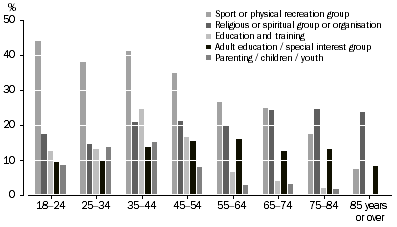
Whether a person does any voluntary work might be influenced by whether their parents have done voluntary work. In total, 52% of the population in 2006 reported that their parents had done voluntary work. Of those people who reported that they did voluntary work in the last 12 months (34% of the total population), 66% said their parents had done voluntary work. The proportion of people whose parents did voluntary work was higher for younger persons (60% of 18 to 24 year olds) and lower for those in older age groups (35% for those aged 85 years or more) (table 30).
CRIME AND SAFETY
Feelings of safety
The feelings people have of safety or lack of safety when alone at home often relate to: perceptions of crime levels in their vicinity; previous experience as a victim of assault or household break-in; relationships with people living nearby; sense of their own strength and capacity to be in control; and their level of trust in their local community.
In 2006, the majority of people (86%) reported that they felt safe or very safe at home alone after dark, while less than half (48%) of people reported feeling safe or very safe walking alone in their local area at night (table 2). Men were more likely than women to feel safe/very safe. Feelings of safety for males and females decreased significantly with age when walking alone at night. Younger females aged 18 to 24 years were the least likely to feel safe or very safe at home alone after dark (69%) (tables 3 and 4 and graph 6).
6 Feels Very safe/safe at home alone after dark, By sex
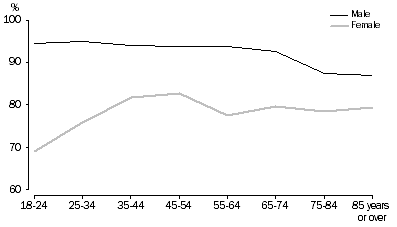
In 2006, people were more likely to feel unsafe at home alone after dark: if living in major cities; if living in accommodation rented from state or territory housing authorities; if not in the labour force; if born overseas in a country other than main-English speaking ones and not proficient in spoken English; if have fair to poor health; or if living as a member of a low income household.
Changes in collection methods for feelings of safety prevent comparisons of 2006 and 2002 results (see Explanatory Notes for more information).
Crime victimisation
The level of crime is an indicator of community wellbeing that is of interest both to governments looking for solutions and to people trying to manage the daily circumstances of their lives. Readers should note, however, that the reported level of crime victimisation can differ depending on the way the information is collected. In particular, the results from the GSS differ from the results from the ABS's National Crime and Safety Survey. Further details comparing GSS findings with other crime victimisation data sources can be found in Appendix 3 of this publication and in the Information Paper: Measuring Crime Victimisation, Australia: The Impact of Different Collection Methodologies (cat. no. 4522.0.55.001).
The GSS collected information about the prevalence of physical or threatened violence against a person, and actual or attempted break-ins to homes, garages or sheds. For all persons aged 18 years and over, 11% reported being victims of physical or threatened violence in the last 12 months, a slight increase since 2002 (9%). However being a victim of actual or attempted break-in fell over the same period from 12% to 9% (table 1).
Men were more likely (14%) than women (8%) to be the victim of violence, with younger men (18 to 24 years) the most likely (31%) to have been a victim of physical or threatened violence (tables 3 and 4).
PERSONAL STRESSORS
Personal stressors are events or conditions that may adversely impact on an individual's life or the collective lives of families. A stressor may impact on an individual through direct experience, such as the individual suffering from a serious illness or being unable to find a job, or indirectly through a family member's illness or inability to find a job, or the divorce or separation of parents. In some instances, the adverse impact of personal stressors may have an ongoing impact on an individual's capacity to live a satisfying and productive life, or the capacity for a family to live as a fully functioning family unit.
The 2006 GSS collected information on several types of stressors that people considered had been a problem to themselves, their family and close friends in the last 12 months. No information was collected on the number of instances for each type of stressful situation experienced, nor on the degree to which the person was affected. Financial stress is discussed separately.
More than half (59%) of Australians aged 18 years and over experienced at least one potentially stressful situation or event in the last 12 months, a similar level to that in 2002. As was the pattern in 2002, a higher proportion of females reported at least one stressor (62%) than males (57%), although across both sexes the prevalence of stressors was highest in the 35 to 54 years age group (tables 1 and 2).
The most common types of stressors were serious illness of self or someone close (reported by 23% of the population); and death of someone close (21%). Other frequent stressors experienced by the respondent or affecting someone close to them included: the inability to get a job (13%); divorce or separation (11%); mental illness (11%); and alcohol or drug related problems (9%) (table 33). These patterns in the most common types of stressors have not greatly changed between 2002 and 2006.
The proportion of people experiencing personal stressors was influenced by family and household composition. A higher proportion of people in lone parent households experienced one or more stressors in the last 12 months (74%) compared to people in couple households with dependents (59%). For couple only or lone person households where one person was aged less than 35 years, 60% of adults experienced one or more stressors. About half of those in couple only or lone person households where one person was aged 65 years or more experienced personal stressors in the last 12 months (table 8).
Other factors influencing the proportions of people experiencing personal stressors were employment status, health and disability status, and whether they were born overseas.
HEALTH AND DISABILITY
The majority of Australians (84% of persons aged 18 years and over) consider themselves to be in good, very good or excellent health, with little change since 2002. The proportion of persons reporting fair or poor health generally increased with age, from 7% of those aged 18 to 24 years to 39% of those aged 75 years or over. Conversely, the proportion of people reporting good or better health and no disability or long-term health condition decreased dramatically with age, from 73% of those aged 18 to 24 years to 9% of those aged 85 years or over (tables 1 and 2).
7 Self-assessed health status, By age
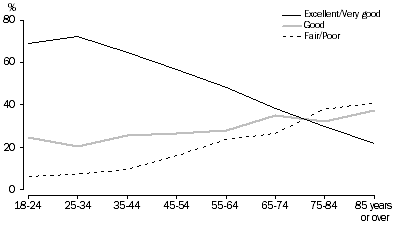
Personal health appears to be correlated with household income. Of those persons in the lowest quintile (i.e. the bottom 20% of people ranked by their equivalised gross household incomes), 35% assessed their health as fair or poor, compared to 7% for those in the highest quintile (table 9).
TRANSPORT
Lack of access to transport due to problems of affordability, safety, availability, convenience, and appropriateness of the type of transport available can act as a barrier to people's participation in the range of social, civic and economic activities of mainstream society.
Most people aged 18 years or over (84%) felt that they could easily get to the places where they needed to go; 12% felt that they sometimes had difficulty getting to such places; while 4% felt that they either could not get to places where they needed to go or often had difficulties in doing so. People's ease in getting to places they need to go may be explained by the large majority of people (86%) with access to a motor vehicle (table 1).
Persons in the youngest age group (18 to 24 year olds) and the older age groups (75 years and over) were the least likely to have access to motor vehicles and more likely to experience difficulty getting to places they needed to go (table 2). Females were less likely than males to have access to motor vehicles and more likely to experience difficulties in getting to places they needed to go (tables 3 and 4).
These patterns in transport and access to motor vehicles have remained largely unchanged between 2002 and 2006.
HOUSING MOBILITY
The 2006 GSS collected information on housing mobility, showing that 6,574,000 (43%) of persons aged 18 years and over moved in the five years prior to the survey. Many factors influence a person's propensity and reasons to move. The GSS showed that people who have been more mobile in the last 5 years tend to be: in the younger age groups (75% of 25 to 34 year olds compared to 15% of those aged 85 years or more - table 2); renting through private landlords (84% of such renters - table 11); or unemployed (62% of those who are unemployed had moved - table 10). Those states or territories with a higher mobile population compared to the national average were the Northern Territory (61%), although this measure is based on the GSS surveying in mainly urban areas only in the Northern Territory, and Queensland (54%) (table 6). Persons who reported poor health were less likely (33%) to have moved in the previous 5 years (table 15).
Overall, the most common main reason for moving was housing related (52% of movers), followed by family reasons (26%). When reporting all reasons for the latest move, the common types of housing reasons were wanting a bigger/better home (19% of movers) and purchasing own home (15%). Other reasons reported by people who have moved included lifestyle change, migration to and within Australia, and issues with their previous neighbourhood (table 35).
INFORMATION TECHNOLOGY
Australian's use of computers and the internet increased substantially between 2002 and 2006. In 2002, just over half (55%) of respondents reported using a computer at home in the 12 months prior to interview. In 2006 over two-thirds (69%) had done so, with accessing the internet at home increasing from 43% to 60%. While males remain more likely to use computers and access the internet than females, the increases in computer and internet use over this timeframe were greater for females. In particular, the proportion of females accessing the internet increased from 39% in 2002 to 58% in 2006, while use by males increased from 47% to 61% (table 1).
8 Internet access, By age and sex
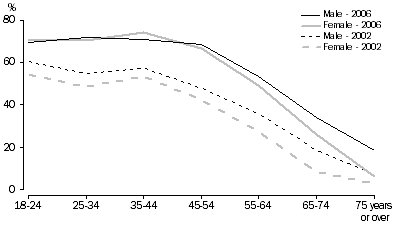
Main reasons for internet usage also shifted between survey cycles, with education and study purposes no longer the most common reasons for access. In 2006, more people reported using the internet for work-related reasons, accessing government information and lodging government forms, such as tax returns, electronically. The internet was also more likely to be used for personal or private reasons, with 40% of all people reporting their main reason for using the internet at home was for personal or private reasons in the 12 months prior to interview.
VISA STATUS
A visa, or travel authority, represents permission or authority granted by Australia for foreign nationals to travel to Australia. In 2006, the GSS collected information relating to the visa status of respondents who were born overseas, who arrived in 1985 or later and were long-term or permanent residents of Australia at the time of interview. This group represented 1,949,000 persons aged 18 years and over. Of this group, 75% had entered Australia under permanent resident visas, another 13% were New Zealand citizens and 10% had entered as long-term temporary residents (table 37 and graph 9).
9 Visa status
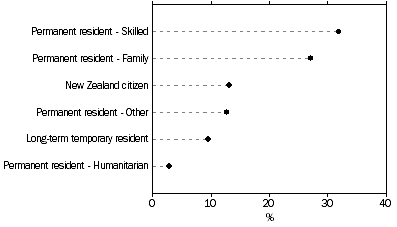
Of all people born overseas, arriving in 1985 or later for long-term or permanent settlement, and still resident in Australia in 2006, slightly less than a third (30%) were from main English-speaking countries. Those born in other countries and reported to be proficient in spoken English accounted for 57% of Australian residents born overseas. The majority of Australian residents born overseas (72%) were employed either full or part-time, although employment was most common among skilled permanent residents (81%) and least common for Humanitarian permanent residents (57%) (table 37).
FINANCIAL STRESS AND INCOME
The financial stress indicators and income data collected in the GSS can provide insights into the economic wellbeing of various groups in the Australian community. Some of the financial stress questions required objective answers, but the interpretation of the responses as indicators of financial stress are subjective. Other questions are inherently subjective in nature. While some of the indicators (such as seeking assistance from welfare/community organisations) appear to be more severe than others, such as 'could not pay electricity, gas or telephone bills on time' it is difficult to rank or weight them in order to derive a single measure of intensity of financial stress.
Compared to 2002, fewer people reported having one or more cash flow problems in the 12 months prior to interview (18% in 2006 compared to 20% in 2002). Fewer people reported that they were unable to pay bills on time, such as electricity, gas or telephone, that they had to pawn something to raise cash, or that they sought financial help from family or friends. Overall, a similar proportion of all people in 2002 and 2006 reported taking one or more dissaving actions in the last 12 months (tables 38 and 39). There was also a pattern of general decline in financial stress, as measured by these indicators, as age increased (graph 10).
10 Selected financial stress indicators, By age
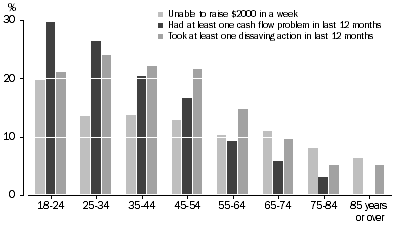
Differing household composition was associated with different levels of financial stress. For example, of the 623,000 adults in lone parent households with dependent children, 38% reported that they could not raise $2,000 in an emergency, compared with 11% of the 4,574,000 adults in couple households with dependent children; 48% of adults in lone parent households had at least one cash flow problem (19% for adults in couple households with dependent children); and 34% of adults in lone parent households took at least one dissaving action (23% for those in couple households with dependent children) (table 38).
The reporting of financial stress does not necessarily imply that a household has low income. Some people in high income households reported financial stressors. Nevertheless, comparing the income characteristics of those experiencing financial stress shows that those in the lowest income quintile (the bottom 20% of people ranked by equivalised household income) were less likely than other people to be able to raise money quickly for something important, more likely to have experienced cash flow problems in the last 12 months, and more likely than people in the top income quintile to have taken a dissaving action in the past 12 months (table 39 and graph 11).
11 Selected financial stress indicators, By equivalised household gross weekly income
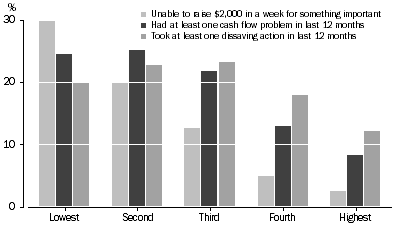
CULTURE AND LEISURE
In 2006, the number of people aged 18 years and over who attended cultural venues and events in the 12 months prior to interview was approximately 13,563,000 or 89% of total persons of this age. While the total proportion of people attending cultural venues and events has not changed since 2002, the types of cultural venues and events attended have experienced some changes in popularity. The most popular cultural and leisure activities enjoyed by people in 2006 were: going to the movies (69% of persons when reporting all activities enjoyed over a 12 month period); visiting libraries (46% of persons); visiting zoological parks and aquariums (41%); and visiting botanic gardens (40%). The largest increases in attendance from 2002 and 2006 were to classical and popular music concerts, and live performances such as theatre, dance, musicals and opera. There were also some increases in visits to art galleries, libraries and museums (table 40).
12 Types of cultural and leisure venues attended in last 12 months, By age
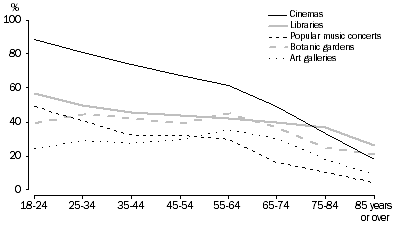
Attendance at sporting events in the 12 months prior to interview also increased, from 48% in 2002 to 52% in 2006. Attending sporting events was more commonly reported by males (60%) than females (45%) and was most popular among young persons (70% of 18 to 24 year olds). Participation in sport or recreational physical activity in 2006 was 62% of all persons aged 18 years and over, which was a similar level to that reported in 2002. However, there has been a slight fall in male participation (from 67% to 64%) over the period. Participation in sport or recreational physical activity remained closely related to age, highest among those aged 18 to 24 years (71%) and declining with age to about one-quarter of people aged 85 years and over (tables 31 and 40).
 Print Page
Print Page
 Print All
Print All